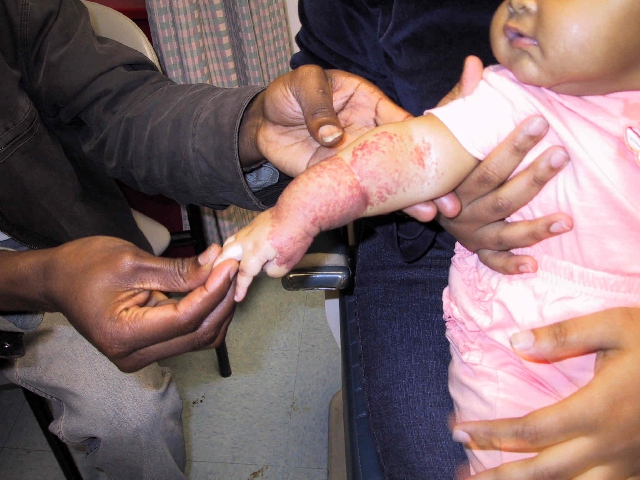CORRECT DIAGNOSIS:
Zika Virus
DISCUSSION:
ZIKV is a single-stranded positive RNA arbovirus belonging to the family Flaviviridae, genus Flavivirus. It is related to West Nile virus, dengue virus, and yellow fever. ZIKV was first isolated in 1947 from a rhesus monkey in Uganda’s Zika Forest.(1) It is a mosquito-borne virus transmitted by various species belonging the Aedes genus. Aedes aegypti and Aedes albopictus are the most common transmitting species and are of particular concern due to their increasing geographic distribution.(2)
For decades following the identification of the virus in 1947, only few sporadic cases of ZIKV were reported in Asia and Africa. In 2013, an epidemic struck French Polynesia with an estimated 28,000 cases.(3) Experts speculate that ZIKV was introduced to Brazil during the 2014 World Cup when participants arrived from the affected Pacific countries.(4) The Brazilian epidemic that followed in 2015 was the largest epidemic in history. Currently, there are over fifty countries and territories with active ZIKV transmission, including 29 locally acquired cases in the United States.(5)
The World Health Organization declared the increased incidence of infants born with microcephaly a public health emergency on 1 February, 2016. A definitive correlation has since been established between ZIKV and microcephaly in infants born to infected mothers. The virus has been isolated from the amniotic fluid of two women who gave birth to infants with microcephaly, and the virus has been identified in the brain tissue of 5 fetuses with microcephaly.(6) Guillain-Barré syndrome has also been positively associated with ZIKV infection. (5)
ZIKV infection may be subclinical in up to 80% of those infected.(7) It is typically a mild, self-limited dengue-like illness with myalgia, headache, fever, arthralgias and conjunctivitis. Typical cutaneous signs include pruritic, blanchable macules and papules beginning on the face then spreading to the trunk and extremities 3-12 days after infection. (5) This is in contrast to the cutaneous manifestations discussed in the above case.
A similar clinical picture may be seen with other mosquito-borne viral illness such as dengue and chikungunya virus. However, these generally result in more severe illness than ZIKV. Severe muscle pain and bleeding complications secondary to thrombocytopenia are characteristic of dengue infection. Chikungunya virus presents with high fever and severe, diffuse joint pain.(8)
Other modes of transmission reported include blood transfusion and sexual transmission. To date, cases of transmission via transfusion have been limited to Brazil. Sexual transmission from males to females, males to males, and most recently, from a symptomatically infected female to a male sex partner have been reported.(5) ZIKV RNA has been detected in semen up to 93 days and in cervical mucous up to 11 days after symptom onset.(9) Infected males and non-pregnant females should use barrier methods or abstain from sex for at least 6 months and 8 weeks respectively after the onset of illness.(10) Importantly, patients with ZIKV infection should be advised to protect themselves from additional bites in attempt to hinder the viral transmission cycle.(5)
TREATMENT:
She was prescribed topical corticosteroid therapy and her cutaneous findings had improved.
REFERENCES:
1.Dick GW, Kitchen SF, Haddow AJ. Zika virus: Isolations and serological specificity. Trans R Soc Trop Med Hyg. 1952;46:509-20.
2.Smith DR, Wikan N. Zika Virus; history of a newly emerging arbovirus. Lancet Infect Dis 2016; 16: e119–26.
3. Cao-Lormeau VM, Roche C, Teissier A, Robin E, Berry AL, Mallet HP, et al.Zika virus, French Polynesia, South Pacific, 2013 [Letter]. Emerg Infect Dis. 2014;20:1085-6.
4.Musso D. Zika virus transmission from French Polynesia to Brazil. Emerg Infect Dis.2015;21(10):1887.
5.Centers for Disease Control and Prevention website. Zika Virus. Available at: http://www.cdc.gov/zika. Accessed August 31,2016.
6. Anderson KB, Thomas SJ, Endy TP. The emergence of zika virus. Ann Intern Med. 2016;165:175-183.
7. Brasil P, Pereira JP Jr, Raja Gabaglia C, Damasceno L, Wakimoto M, Ribeiro Nogueira RM, et al. Zika virus infection in pregnant women in Rio de Janeiro – Preliminary Report. N Engl J Med. 2016.
8.Zika virus infection and Zika fever: Frequently asked questions. Available at: http://www.paho.org/hq/index.php?option=com_content&view=article&id=9183%3A2015-preguntas-frecuentes-virus-fiebre-zika&catid=3986%3Azika-virus-infection&Itemid=41463&lang=en. Accessed August 31, 2016.
9.Mansuy J, Pasquier C, Daudin M, et al. Zika virus in semen of a patient returning from a non-epidemic area. Lancet Infect Dis 2016;16:894–5.
10.Brooks JT, Friedman A, Kachur RE, LaFlam M, Peters PJ, Jamieson DJ. Update: Interim Guidance for Prevention of Sexual Transmission of Zika Virus — United States, July 2016. MMWR Morb Mortal Wkly Rep 2016;65:745–747. DOI: http://dx.doi.org/10.15585/mmwr.mm6529e2. Accessed August 31, 2016.




